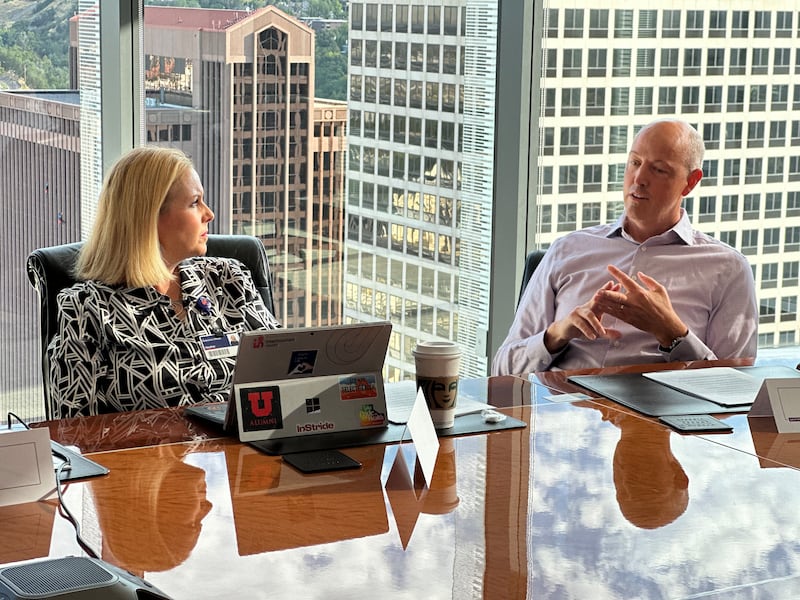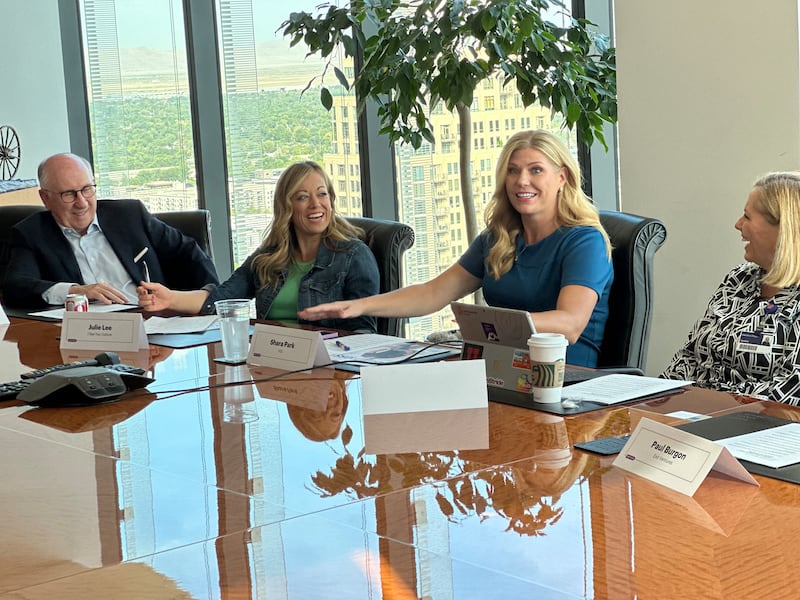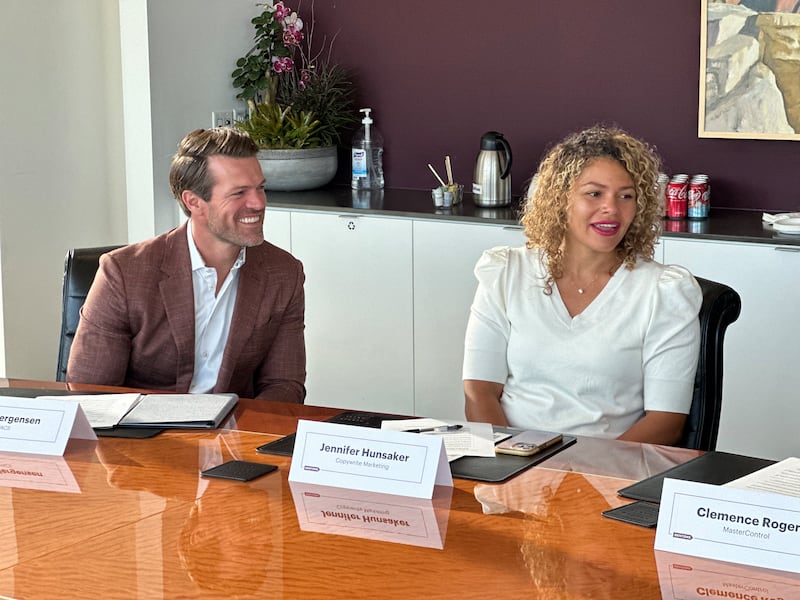Last month, Utah Business partnered with Dentons Durham Jones Pinegar to host a roundtable featuring a selection of this year’s Utah Business Forward speakers. Moderated by Shara Park, breaking news anchor for KSL 5 News, participants discussed tips for small business owners, strategies for maintaining a positive workplace, the importance of storytelling and more.
What strategies should aspiring entrepreneurs focus on when it comes to acquiring businesses, especially if they have limited financial resources?
Jeffrey Jones | Shareholder & Director | Dentons Durham Jones Pinegar
In my experience, for a lot of early-stage companies that want to acquire another business or another important asset, it’s beyond their reach financially. ... You are well served at the early stage to get good advisors. ... Most people are happy to help. Most people are flattered when you ask them if they would give you some help and some input. ... In our electronic world, that particular opportunity is underutilized. Sitting across the table with somebody and having a discussion about the nuts and bolts of your concerns, what you’re trying to accomplish, what your roadblocks are, and what your aspirations are is a different experience.
Troy Keller | Partner | Dorsey & Whitney
What I’ve seen, especially with companies that don’t have a lot of resources, is that they sometimes get overly clever ... and usually don’t get the deal done. They spend a lot of time and a lot of money. Sometimes, not trying to recreate the wheel is good advice. Being clever and thinking outside the box, especially with your strategy, is fantastic when it comes to completing the transaction. But sometimes, the well-trodden path is going to be more efficient and probably lead to a better and longer-term relationship.

What factors should a business consider when deciding whether mergers and acquisitions are suitable strategies for growth within a new business?
Paul Burgon | Managing Partner | Exit Ventures
I’ve led M&A for Fortune 500 corporations for most of my career. … From a corporate perspective, it was easy because we had billions of dollars in the bank, lots of VPs and thousands of employees. But for an entrepreneur of small- to medium-sized businesses, acquisitions are dangerous. ... First, know what and why you’re doing it. And second, you’ve got to have a good advisor. ... You have to do it before the ink is dry and even before you actually sign the paperwork. A lot of companies do an acquisition and then say, ‘OK, this is how we’re going to run the acquired company,’ and half the people leave.
Nick Wenker | Deputy General Counsel & SVP, Legal | Young Living Essential Oils
I’ve noticed a lot of business leaders, even top business leaders, sometimes have wildly unrealistic optimistic expectations about how things are going to go. ... Preparing for the worst and hoping for the best is probably your best strategy going in. And have a good lawyer. ... Even with experienced, seasoned professionals, so often the excitement and the enthusiasm for personal relationships can override, ‘Hey, we really look at options B and C as well, and maybe options B and C are better, even though option A is your best friend from high school.’ … You really need to have a board that has the right people on it where they check each other and check your executives.
What are the most critical factors in maintaining high employee morale and engagement during times of organizational stress and transformation?
Heather Brace | Chief People Officer | Intermountain Health
It starts at the top. If the top people are not aligned, don’t expect the people out in the field to be aligned. … How does this further our mission? How does it further the purpose of my role? It’s all about communication. Anytime we’ve had misses, it’s when we’ve assumed that people know something. … [It’s also important to] find ways to ask people how it’s going. How have they experienced it? What’s been a miss for them? Having people who are able to speak up and share concerns safely has helped us a lot. The last thing is having a willingness to pivot. It may not go right, so can somebody be humble enough to say, ‘We screwed up and there’s another way. Thank you for pointing it out, and we’ll adjust and move forward.’
Clémence Roger | Head, SEO | MasterControl
First, when you go through a transformation or stress, it’s very important to keep trust within your employees and the leadership. ... Second, trust people with their skills and talents. ... Third, adapting is very important rather than resisting change.
Julie Lee | Owner | I See You Leadership
People invest in what they help create. When we make people feel a part of things, they are more likely to want to participate and to have a better attitude. ... It comes so much back to these three things of establishing a human connection with our people, which is that they feel seen, appreciated and trusted. ... If we want people to have loyalty, there is no replacement for that face-to-face mentorship. Face-to-face mentorship is one thing that AI cannot replace.
Nick Wenker | Deputy General Counsel & SVP, Legal | Young Living Essential Oils
When your company is going through a difficult time, I’ve always felt that the three most important things are specificity, authenticity and ownership. ... The last thing you want to do is go into a town hall and have platitudes raining down on you from above. If you hear something that’s specific, authentic and voluntary coming from your top leaders, rather than being deflated by the platitudes, you leave wanting to be part of the team to turn things around or to create more growth, not just because you want the company to do well but also because you feel a relationship and a bond with your top leaders for being honest and real with you.
Troy Keller | Partner | Dorsey & Whitney
As an attorney, we usually advise clients to manage the information with confidentiality in all respects. … But I’ve seen leaders who cut through that and say, ‘We’re going to have a culture of transparency, and we’re going to share. We don’t want our employees to find stuff out after the market does.’ … I’ve had a couple of experiences where I’ve seen that transform a company. I find that to be a very powerful leadership trait, even though that’s not my area of expertise.

What role do mental health awareness and support play in creating authentic and thriving world cultures, and how can leaders actively promote this within their organizations?
Br33 Jon3s | Founder & CEO | GAM3R STUDIOS
When you are stressed, you feel like you’re drowning. You feel like you can’t communicate that to your peers at work. The toll it takes on you and your cognitive ability to work through problems, not just at work but at home and with your kids, gets very intense very quickly, very unmanageable very quickly. ... We’ve made it a priority to create our own nonprofit and a therapy clinic inside of it that works holistically with every individual.
Paul Burgon | Managing Partner | Exit Ventures
Some great articles have come out in just the last two weeks that say, ‘Entrepreneurs, you can’t be working 80-90 hours a week. 1) For yourself, and 2) for your family.’ … As an investor, we want the long-term game. The short-term game is, ‘Yeah, go ahead and work 80 hours a week. It’ll be great for us.’ … But what we want is that in 5-10 years, this business and this team will be wildly successful. The only way they do that is if they find some sort of balance.
Jen Hunsaker | Owner | Copy Write Marketing
There’s a book called “The Good Enough Job” by Simone Stolzoff. In our nation, working constantly is embedded in our culture. We think that working 80-90 hours is what translates to success, and if you don’t, you’re going to fall behind. … [Stolzoff’s] research is about adopting this concept of the job being “good enough.” We don’t need to strive for perfection. … It’s essential for us to be able to say, ‘You know what, that’s enough. I’m closing the computer. I’m turning off my phone. Am I going to have a bucket of work when I come home from vacation? Absolutely. But you know what, we’ve got to get out and go do something.’
Heather Brace | Chief People Officer | Intermountain Health
The audio and video have to match. If we say that mental health is important for our community, our own caregivers have to be the first recipients of it. Otherwise, it’s very hard for them to deliver these mental health services to the communities that we serve.
Josh Jergensen | President & COO | PACS
As a leader, if you make comments like, ‘Oh, another vacation. You’re taking another day off. You’re leaving a little bit early from work,’ even in jest, that conditions us to go, ‘I shouldn’t do that.’ ... Then, employees may take time off, but ultimately, they’re stressed and afraid you’re going to call them on that day, or you’re going to need something that day. ... As leaders, that’s what I would caution is the conditioning of your people. Although you’re saying they should have appropriate mental health awareness and balance in their life, you shame them for doing it.
Jeffrey Jones | Shareholder & Director | Dentons Durham Jones Pinegar
We all have to work 80 hours a week sometimes. ... I send gift cards like spa cards or cards to The Capital Grille and whatever other restaurant I think they’re interested in. ... We can talk all we want about finding a good work-life balance, but we have to recognize that there are times when it doesn’t work. When that’s the case, there’s real value in doing something above and beyond just the paycheck.
For small businesses just starting to incorporate AI analytics into their operations, what are some key strategies to ensure effective data-driven decision-making and improve marketing performance?
Clémence Roger | Head, SEO | MasterControl
I go by the saying, ‘Where performance is measured, performance is improved.’ … If a small business wants to incorporate AI, I would tell them to assess their current analytics. People spend hundreds of thousands of dollars on a campaign, hoping that it’s going to work, but without any measurements or understanding of why it works or doesn’t work. Are you even measuring anything? What do you want to track? ... It’s not just because you integrate AI in your operations that you’re going to get there.
Br33 Jon3s | Founder & CEO | GAM3R STUDIOS
When you understand AI and how it’s built, at a very basic level, it’s a computer that knows how to have a conversation in human language. But when you get more advanced with it, it’s a computer that can research, get data, understand its user’s input and perspectives, and then cumulate that into something that’s highly informative and curated to that unique situation or those individuals working toward that goal. ... My entire presentation for Utah Business Forward is about creating uniqueness around AI. We need to make the AI tools that we use unique and curate that input. … AI really is full of humanity. That’s the whole point of it.

What storytelling techniques can businesses employ to better connect with their audience and retain customer loyalty, particularly in the digital market space?
Josh Jergensen | President & COO | PACS
For us, the storytelling we needed to do was internal — engaging our employees in our mission, how they’re a part of it, and how they’re impacting real people they probably are never going to meet and may never see. I think it’s about understanding who your audience is and then finding stories that will resonate.
Jennifer Hunsaker | Owner | Copy Write Marketing
There are some really practical ways to incorporate storytelling into digital marketing. The UGC and influencer marketing realm is so effective because you’re allowing actual users to tell their experiences. It can be a little risky because there’s no control, but that’s how you make sure your product and the experience you’ve created are good and that it’s working. ... I’ve been influenced by so many purchases just through reading online reviews or watching videos that people have taken. Allowing people to tell their own stories, even some that aren’t curated by the company, is really powerful for people who live much of their lives online.
Julie Lee | Owner | I See You Leadership
Stories are what move people. Stories are what people remember. … I tell pieces of my story that are relevant and relatable, but then I make it about the audience. ... Instead of trying to just relate by telling them a story, I put them in the story and make them think about their own story. I don’t want them to leave and remember my story; I want them to be thinking about how they want to change theirs.


